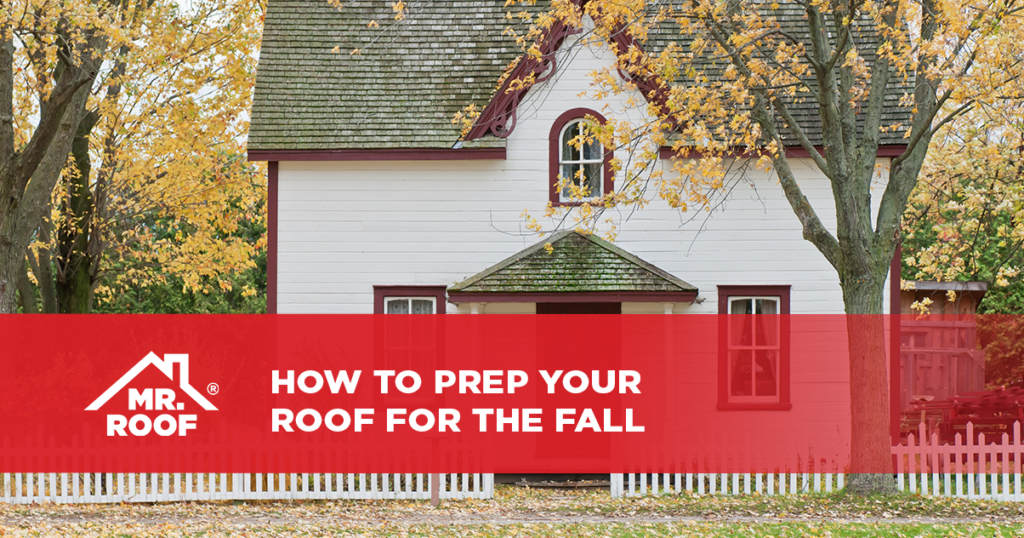Part of maintaining your roof is preparing it properly for the seasons. As summer winds down and fall approaches, it is important to get your roof ready for the elements that accompany the changing seasons. These preparations, in conjunction with annual inspections, should increase the lifespan of your roof and reduce the likelihood of major damage.
Seasonal roof prep checklist
- Clean the gutters
Cleaning the gutters of fallen leaves and other debris is necessary to avoid clogging and overflow. You can clean gutters with an old kitchen spatula or find a scoop specifically made for the job for a low cost at your local home improvement store. Clogged gutters can lead to damaged roofs, siding, and trim. The weight of the gutters could also become a problem since they can become heavy and put a strain on the places where your roof secures the gutters. - Consider installing a gutter guard
Gutter screens or guards help to prevent clogged gutters by blocking debris from entering the gutters. They do require upkeep, as you’ll need to remove the debris from your roof that is no longer able to enter the gutters. - Check for damages
Prior to fall is a perfect time to get your roof professionally inspected each year to ensure it is ready for the harsher weather. If you do not schedule a professional inspection, a self-inspection should be done. Get as close as you safely can to your roof and inspect for damaged shingles, cracks, or leaks. - Check for leaks
If you notice mold or water spots in the walls or ceiling of your home, this is likely a sign your roof is failing somewhere. Remember to check the attic, as it is the closest inside source to your roof. From the outside, leaks may be evident. If you can see water pooling and draining on your roof or there are obvious cracks or damage to your roof, it may be a sign of leaks. - Remove debris
Debris on your roof, even if they seem small, can create problems due to erosion. Additionally, debris can eventually fall into gutters and cause clogging. Of course, make sure you can clear any debris safely on your own, or contact a professional if you do not have the correct safety equipment to reach the debris. - Inspect and repair insulation inside the home
As the temperatures prepare to drop, make sure your insulation is intact and free of mold. Poor insulation can lead to a melting-freezing cycle that can cause ice dams and damage the integrity of your roof. - Make repairs
Once snow and ice arrive, making repairs is more difficult and can be more costly. Letting an issue sit over winter can also be a poor decision as the cold and snow can make the problem worse by the time spring arrives. Inspect your roof and make repairs prior to the colder weather when possible.
Signs your roof is losing heat
Other than obviously providing cover for your home, one of a roof’s main functions is securing heat within your home during the colder weather. Warm air can seep out through cracks and holes in your roof, leading to a higher home heating bill and possibly water damage in the future. There are signs to look out for if you think you may be losing a substantial amount of heat through your roof:
- No snow on the roof
This could indicate that snow is melting as soon as it hits your roof because your roof is warm from the air that is escaping from inside the house. While too much snow on your roof can cause damage, disappearing snow after a storm can be a sign something is wrong. - Gaps between the ceiling and the roof that aren’t filled with insulation
Warm air will attempt to escape out of your roof if there is no insulation barrier between the heat and the roof, so inspection of your insulation, especially in the attic, is important to avoid heat loss. - Leaks or condensation in your home
If your roof is letting water in, it is likely able to also let warm air out. Take any leaks or water damage you see within your home seriously and have a professional inspect your roof to see where the problem is.
Mr. Roof can help
If you suspect you’re losing heat through your roof or notice damages during your fall inspections, our experienced team can recommend and complete necessary repairs, as well as help increase the efficiency and lifespan of your roof. Contact Mr. Roof today for a consultation to get your roof in tip-top shape before the cold weather arrives.









